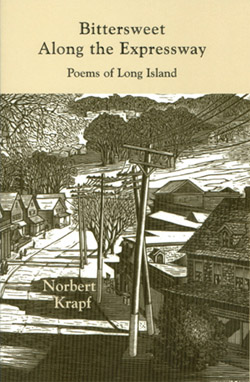Poems of Long Island

When the Everyday Becomes a Transforming Experience
Poet's Tasting of Bittersweet
By Avital Louria Hahn

When the Everyday Becomes a Transforming Experience
Poet's Tasting of Bittersweet
By Avital Louria Hahn
The title of Mr. Krapf's newest book, Bittersweet Along the Expressway: Poems of Long Island (Waterline Books) refers to a common vine seen along highways. "It catches both the positive and the negative aspects of life here," said Mr. Krapf, who directs the Poetry Center on the C.W. Post Campus of Long Island University.
 Bittersweet concludes a trilogy about places that shaped Mr. Krapf's experience. The writer's forebears were German immigrants and early settlers of Jasper, Ind., in the 1840's. With 81 poems and a soft, glossy cover bearing a woodcut of Old Roslyn, Bittersweet has a fresh and lyrical take on Long Island. It is also a perfect antidote for cynics who see Long Island as a maze of highways and malls.
Bittersweet concludes a trilogy about places that shaped Mr. Krapf's experience. The writer's forebears were German immigrants and early settlers of Jasper, Ind., in the 1840's. With 81 poems and a soft, glossy cover bearing a woodcut of Old Roslyn, Bittersweet has a fresh and lyrical take on Long Island. It is also a perfect antidote for cynics who see Long Island as a maze of highways and malls.
As with Whitman and Bryant, aspects of local life, like a pheasant, a cardinal and an old house in Orient Point, are material for Mr. Krapf. "One of the things that the book shows is the heartfelt kinship with the poetry spirits of the past, especially with William Cullen Bryant and Walt Whitman," said William Heyen, emeritus poet in residence at the State University of New York in Brockport.
The book's nucleus is its first poem, "Arriving on Paumanok." It gave rise to dozens of poems, including "Bittersweet Along the Expressway," "Sycamore on Main Street," and "Gatsby Country." Paumanok is an Algonquin name for Long Island, which, according to Walt Whitman, means "The island with its breast long drawn out."
Rolling unfamiliar Indian names like Manhasset and Ronkonkoma on his Midwestern tongue was one of the first encounters Mr. Krapf had with the island. This encounter is the subject of "Arriving on Paumanok." "This is a poem I wouldn't have written if I had grown up here," Mr. Krapf said. "I came to these place names as an outsider. I was like a little kid crawling on the floor of my study with a map of Long Island stretched out in front of me, trying to say out loud the haunting Indian place names."
Arranged in four parts, the poems narrate Mr. Krapf's move to Long Island. He and his wife, Katherine, an English teacher in Manhasset Middle School, moved into a historic house on Roslyn's Main Street near Cedarmere, home of William Cullen Bryant. This house and the 1925 Dutch Colonial in Roslyn Heights the Krapfs moved into in 1990 are frequent settings for the book's poems. The poems also focus on the arrival of the Krapf's two Columbian infants in the early 1980's. Love of gardening and the Island's natural history is woven throughout the book, but the poems also return to the southern Indiana of the author's youth.
"Norbert is for me a poet of long staring, he is very patient and as Wordsworth said, the poet is involved in a priestly call," said Vince Clemente, professor emeritus of English at Suffolk College and a former trustee of the Walt Whitman Birthplace. "Norbert lives that calling in his teaching and writing."
The New York Times, Sunday, June 24, 2001

www.krapfpoetry.net